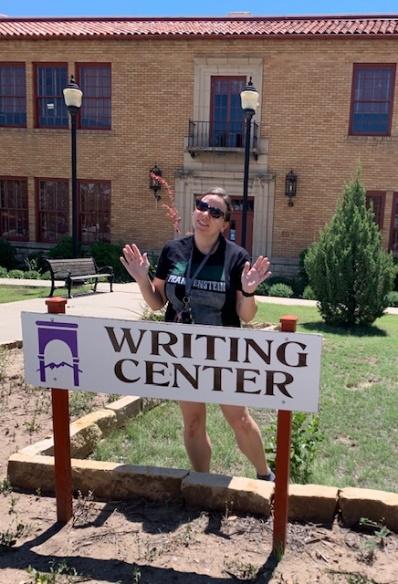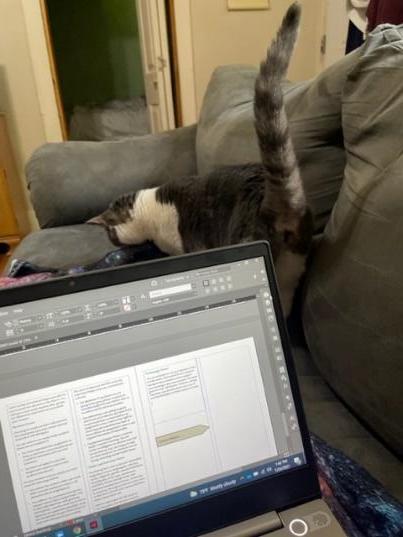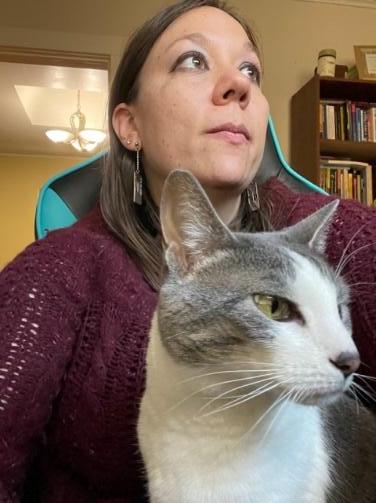By Amanda May, New Mexico Highlands University
Let me Tell You A Story
Picture it: Tallahassee 2020. I was preparing to send my dissertation to the committee for my defense after a tumultuous final semester as assistant director. No part of writing center experience or scholarship prepared me to help transition from in-person services to fully online services in response to the pandemic, facing challenges similar to those described by Marilee Giles and colleagues.
To make matters more difficult, I was also on the job market. With no offers in hand, I was mentally preparing myself for another year in Florida as a post-doctoral teaching fellow.
Then, the offer came.
The next few months consisted of completing new hire paperwork, searching for a house to rent, booking movers, packing the past five years of my life into boxes, and tutoring for 20 hours a week at the writing center. I left Florida at the end of July and arrived in New Mexico several days later. After two weeks quarantining, unpacking and adjusting to a new climate, altitude, time zone, and town, I became New Mexico Highlands University’s Writing Center Director in Fall 2020.
Back Where I Come From

Highlands was my fifth writing center in a 12-year long career. I knew the theory from my dissertation and from several courses, one of which I TAed in as assistant director. I knew the practice from years of working in various tutoring capacities and providing both formal and informal mentorship. Yet in each position, I was almost always on site.
Becoming a new writing center director during the pandemic meant that my sense of place was largely limited to the screen. I knew NMHU was a small, public comprehensive Hispanic-serving institution located in rural New Mexico (“About”), very unlike all of my previous institutions. And I knew that context plays a role in shaping writing center work (Caswell et al.). But in the absence of any physical sense of place beyond walking through campus, both virtually and physically now that I was there, I felt lost. My impressions of students, tutors, and faculty were mostly reduced to Zoom windows, so I walked away from most interactions knowing voices. If I passed any one of these people in the local grocery store (as often happens here), I would not recognize them. And that raised another issue.
As they say in St. Olaf
In my previous positions, I always had several workspaces, usually including the writing center, the library, and at least one coffee shop. I can’t tell you how many times moving between these jumpstarted my productivity and helped me shift gears. The pandemic, however, limited my workspace to my rental house.

Space is a notion Alex Claman and colleagues explore as writing tutors. For them, COVID “collaps[ed]” home space and writing center space and centralized digital spaces, causing them to intrude upon home spaces in ways that eroded their separation. The best I could do was move between the living room and office, but that seldom sufficed.
Like Claire in Clamen et al.’s piece, I also faced unique challenges as a new employee as the proverbial stranger in a strange land. Being in the rental house constantly without having anywhere else to go became tiring. My knowledge of this new place was limited to walking, grocery shopping, and occasionally getting carry-out. I was teaching largely to black boxes on Zoom, and because I knew many students were from low-income families in towns smaller than the one I lived in, I didn’t feel comfortable forcing them to have their cameras on due to unstable connections. There was also an added frustration of knowing that a physical writing center existed but not being able to see it.
I Just Drink Whatever’s in the Glass
My past writing centers positions included plenty of administrative work: former titles include online co-coordinator, coordinator, and assistant director. But in all those positions, the physical space of the writing center meant that community, collaboration, and communication—three cornerstones of writing center theory and practice—naturally emerged.
But with the pandemic, I really grappled to connect with my tutors, as well as connect them to each other, not only because we were all working online, but also because we were working across multiple countries and time zones. I tried successful approaches from my prior writing center experiences: biweekly meetings, emails, Group.Me. None of them seemed to work.
With the institution, the issue became even more muddled, and yet, some good came out of it. The Legislative Fellows program coordinator called me thinking I ran an online asynchronous tutoring service instead of the writing center. As a result of that phone call, we set up a collaboration. The director of the program agreed that the writing center could do a workshop for applicants, which I co-presented with two tutors. We have continued that collaboration, and I hope it continues in AY 2022.
Suddenly . . . You Find yourself Swimming Upstream
As a long-time writing center employee, I was familiar with the labor issues that writing center directors face. My experience and scholarship made me well-informed of the abundance of tasks new writing center directors often found themselves juggling, from emotional labor to everyday administrative tasks to tutoring, teaching, and other service roles. The abundance of commitments often cause writing center directors—both new ones (Caswell et al.) and those working in pandemic times (Young) to feel unheard and burnt out.
Nothing fully prepared me for the leadership roles I took on in my new position, partly because of the nature of the place: other members of the department, like me, are always busy. I volunteered to chair a job search in my first semester, and in my second, I volunteered to fill the role of graduate coordinator on what I thought was an interim basis. It wasn’t. And just like that, I found myself teaching a three-course load while juggling not one but two administrative roles at the beginning of my second year.
But Honey, if you Don’t take a Chance, Nothing Happens

Picture it: New Mexico, 2021. It’s the beginning of my second year as the writing center director. With my extensive email signature in hand, I finally, finally get to open the time capsule that is the writing center. Bits of the 2020 schedule, paper surveys, a thick layer of dust, the old schedule on the whiteboard. There are notes stuck up on the board by the front desk: a grocery list (Advil is on there, marked “LOL JK”).
Of course, my joy is short-lived when we go back online for two weeks at the beginning of the fall semester, and I grow increasingly troubled as the COVID figures for campus keep ticking upward. Several entire sports teams contract it. We continue to require masks indoors until mid-spring 2022, at which point I of course contract COVID.
It’s true that the pandemic shift has increased accessibility (Westfall) and brought mental health issues to the forefront of writing centers (Giaimo). But this isn’t the writing center I would have come to had the pandemic never happened. My tutors mask. We host an abundance of online sessions, which I have opened to everyone on campus and not just students working remotely. We try to social distance, but onsite work doesn’t always allow for that kind of space.
When we go back on site, we do double the sessions we did in Fall 2020 with slightly over half of the tutors. Personnel issues grow worse in the spring as graduate enrollment decreases: I start the spring semester with 2.5 GAs and wonder how the writing center is going to serve campus with such limited staffing. I also wonder how I’m going to curb the pre-midterm and pre-finals week rushes and how I’m going to protect my tutors from inevitable burnout. In the end, I try. I likely don’t succeed. But as I’m writing this, we are approaching the last week of class, and once again, we’ve almost made it through.
I acknowledge my story is not the story of others, but in sharing mine, I hope to help preserve this pivotal moment in writing history as we begin to think more about the state of writing centers as we transition once again to a late—and hopefully post—pandemic world.
Works Cited
“About.” New Mexico Highlands University. Accessed 15 Apr. 2022.
Brooks-Gilles, Marilee, Lisa Bell, J. M. Dembsey, and Duane Theobold. “Writing Center Administrator Guidance in Response to the COVID-19 Pandemic: The Progression of a Position Statement.” The Peer Review, vol. 5, no. 1, 2021. Accessed 1 Sept. 2021.
Caswell, Nikki, et al. The Working Lives of New Writing Center Directors. Utah State UP, 2017.
Claman, Alex, et al. “Sheltering in Place, Working in Space: Reflections on an Online Writing Center at Home.” The Peer Review, vol. 5, no. 2, 2021.
Giaimo, Genie N. “Laboring in a Time of Crisis: The Entanglement of Wellness and Work in Writing Centers.” Praxis: A Writing Center Journal, vol. 17, no. 3, 2020.
Westfall, Kennedy. “Transitioning to an Online Writing Center: Encouraging Inclusivity and Accessibility through the COVID-19 Pandemic and Beyond.” 2021. Master’s Essay. John Carrol University.
Young, Maria Soriano. “Labor of Love, or Love of Labor? What It Means to Be a Writing Center Director During the Pandemic.” NEWCA Workshop Series on Labor Studies, 30 March 2022, Zoom. Workshop.

Amanda M. May is an assistant professor of English and the writing center director at New Mexico Highlands University, where she teaches courses in first-year writing, advanced composition, and technical writing and coordinates the department’s graduate program. Her first writing center job was in 2007 as an undergraduate tutor. Since then, she has held multiple tutoring and administrative positions in writing centers. She also spent two years teaching English in Japan. Her upcoming publications focus on aleatory play in video games and social media use and non-use in writing centers.


Great post Amanda! It’s in line with what many of us are experiencing during this post-pandemic world, even in Australia.